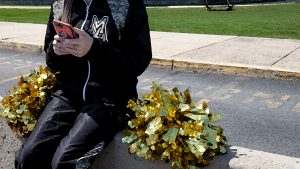The June 23, the United States Supreme Court issued its decision in a First Amendment student speech case marking the first time the Court has taken up the issue in over fifty years. The case involved off-campus student speech taking place outside of school hours. This case will have a lasting impact on a school’s ability to regulate off-campus speech.
 This case, Mahanoy Area School District v. B.L., arose after a high school freshman tried out for the varsity cheerleading team, but instead made the junior varsity team. That weekend, the student “B.L.” used her own cell phone to post two photos to her story on SnapChat. The first image she posted was of her and a friend with middle fingers raised and captioned it “Fuck school fuck softball fuck cheer fuck everything.” The second image she posted was blank but captioned “Love how me and [another student] get told we need a year of jv before we make varsity but tha[t] doesn’t matter to anyone else?”
This case, Mahanoy Area School District v. B.L., arose after a high school freshman tried out for the varsity cheerleading team, but instead made the junior varsity team. That weekend, the student “B.L.” used her own cell phone to post two photos to her story on SnapChat. The first image she posted was of her and a friend with middle fingers raised and captioned it “Fuck school fuck softball fuck cheer fuck everything.” The second image she posted was blank but captioned “Love how me and [another student] get told we need a year of jv before we make varsity but tha[t] doesn’t matter to anyone else?”
The cheerleading coaches were made aware of the posts and other students came to the cheerleading coaches “visibly upset.” The posts were also discussed during an algebra class taught by one of the cheerleading coaches for 5 to 10 minutes for a couple of days. B.L. was suspended from the JV team for one year because of her SnapChat posts.
Supreme Court Rules Cheerleader’s Off-Campus Speech Protected
B.L. sued the school district claiming that her suspension from the junior varsity cheerleading team violated her First Amendment Rights. The Supreme Court ruled that B.L.’s posts were entitled to First Amendment protection because (1) her posts did not include speech that would place it outside of the First Amendment’s ordinary protection; (2) her posts appeared outside of school hours on her own time and while she was off campus and (3) her posts did not cause a substantial disruption at school.
Features of Protected Off-Campus Speech
The Supreme Court defined three features of off-campus speech that often, if not always, will lessen a school’s unique First Amendment leeway. The Supreme Court articulated these features as follows: (1) in off-campus speech (unlike on-campus speech), a school will rarely stand “in the place” of a student’s parents; (2) from the student speaker’s perspective, regulations of off-campus speech, when coupled with regulations of on-campus speech, would include all speech of a student 24-hours a day; and (3) the school itself has an interest in protecting a student’s unpopular expression, especially when that happens off campus. The Court did note that not all off-campus speech will be protected, and listed certain circumstances where a school may be able to regulate off-campus speech. For example, serious or severe bullying or harassment targeting particular individuals or threats aimed at teacher or students.
The Supreme Court did not draw any bright lines on what off-campus speech is and is not protected by the First Amendment. School districts will have to examine each situation as it presents itself to determine if off-campus student speech is afforded the protections of the First Amendment. We will be examining the Supreme Court’s decision in detail during our Annual School Law Summer Seminars. For more information and to register visit www.mickesotoole.com/sls21.
For more information on student First Amendment Rights, please contact us.
